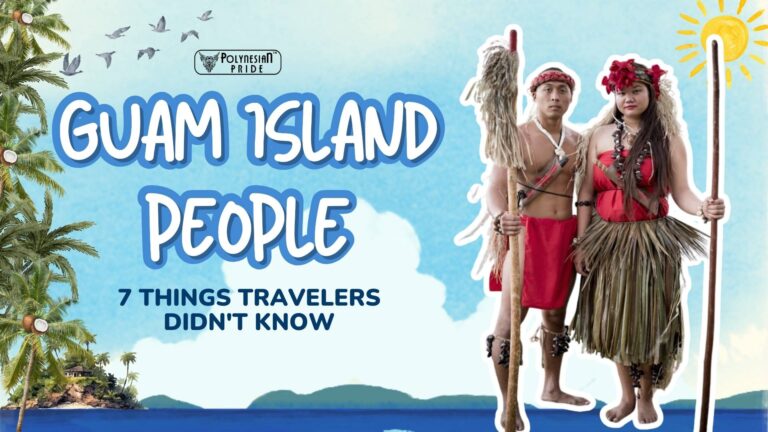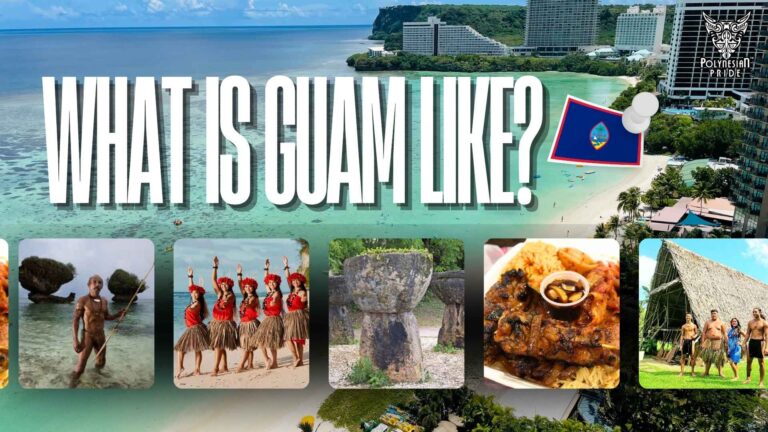Samoa Culture Facts: 17 Things That Make You Mind-Blowing

Welcome to Samoa!
Nestled in the heart of the South Pacific, Samoa boasts a history as vibrant and diverse as its lush landscapes. These 17 Samoa culture facts will inspire you to pack your bags and explore this fascinating paradise island.
Samoa Culture Facts No. 1: The only “Cradle of Polynesia”
Samoa’s position in Polynesia is distinctive, earning it the moniker “Cradle of Polynesia”. Samoa is due to the widely held belief that Samoa is the ancestral homeland of several Polynesian cultures, adding to its significance in the region.
Linguistic Ties: The Samoan language shares vocabulary, grammar, and syntax with other Polynesian languages, hinting at Samoa’s role as the birthplace of the Polynesian language family.
Cultural Diffusion: Samoan voyagers spread their cultural practices, like traditional dances and tattooing, across other Polynesian islands, cementing Samoa’s status as a cultural wellspring.

Samoa Has Only One City
Surprisingly, Samoa has only one city – Apia. Situated on Upolu Island’s northern coast, Apia is Samoa’s bustling capital, serving as a vibrant hub for commerce, culture, and government.
Historic Significance: Apia is Samoa’s urban core and houses one-fifth of the country’s population. Despite its city status, Apia maintains a laid-back charm, blending modernity with traditional Samoan culture. Apia’s historical importance as a port for European powers during Samoa’s colonial era is evident in its architecture, museums, and cultural sites.
Cultural Melting Pot: As Samoa’s commercial and administrative hub, Apia blends Samoan traditions with global influences, enriching its culinary scene, arts, and lifestyles.

Two Nations, One Culture
Before colonization, Samoa and American Samoa were unified as one nation with a shared culture, offering an intriguing insight into Samoa’s history. This unified entity represented a cohesive community with strong cultural ties. Despite the division caused by colonization, the essence of their shared heritage persists to this day.
Today, while Samoa and American Samoa are separate countries, they remain deeply connected through their language, customs, and ancestral bloodlines. This enduring bond serves as a testament to the resilience and continuity of Samoan culture across geographical boundaries.

Samoa Is the First Country To See the New Day
Samoa, located just west of the International Date Line, is among the first to witness each day’s sunrise, making it a unique destination. The International Date Line, an imaginary boundary, separates calendar days and standardizes time zones globally. This strategic location holds cultural significance for Samoans, symbolizing their connection to nature and the Pacific. Welcoming the new day is a cherished tradition, often marked with ceremonies and gatherings.

Samoa Culture Facts No.5: The Legend of the First Coconut Tree
“Sina and the Eel” is a Samoan legend that explains the origin of the first coconut tree, and it’s one of the many intriguing Samoa fun facts. This tale has multiple versions across Oceania, but one from Samoa’s Savai’i island tells a unique love story.
In this version, a beautiful girl named Sina had a pet eel. As the eel grew, it fell in love with Sina. Frightened by her pet’s change in behaviour, Sina fled to a village for safety. One day, while fetching water from a pool in the town, Sina saw the eel staring up at her. She cried for help, and the villagers rescued her, killing the eel.
Before dying, Sina honoured the eel’s final request to bury its head in the sand. Soon after, a coconut tree sprouted from the spot. Removing the husk of the coconut revealed three marks resembling the eel’s eyes and mouth. One of these marks was pierced for drinking, making it seem as if Sina was kissing the eel whenever she drank from it.
This legend endures in Samoa, linking a pool named Mata o le Alelo in Matavai village to the story. This myth is just one of the fascinating Samoa fun facts highlighting the islands’ rich cultural heritage.

Pointing Your Toes at Someone Is Considered Rude
In Samoan tradition, feet are considered the body’s lowest and least clean part. Pointing the sole at someone is seen as disrespectful. Samoan teachings instruct individuals to sit with their feet tucked to the side or underneath, ensuring their soles never face others. This practice highlights the importance of respect in Samoan society. Efforts to educate visitors about this custom help foster understanding and appreciation of local traditions.

Importance of Samoa Culture Facts: Respecting Elders

In Samoan culture, respecting elders is a deeply rooted value instilled from a young age, sometimes making kids grumpy as they navigate these expectations.
The Fa’amatai System: Central to Samoan society is the fa’amatai system, a hierarchical structure where elders, or matai, hold significant authority and are treated with the utmost respect.
Cultural Expectations: Samoan elders teach children certain customs for interacting with them. These include using respectful titles, avoiding direct eye contact, and speaking only when spoken to. Not adhering to these traditions is considered disrespectful and may result in disciplinary measures.
Navigating Childhood: While respecting elders is essential, it can be challenging for Samoan children, leading to frustration. However, as they grow, they appreciate the importance of these traditions in maintaining community harmony.
Samoa Kids Have Their Day Called “White Sunday”
In Samoa, children are celebrated on “White Sunday”, a special day honoring their importance in society. This tradition, an integral part of Samoa culture facts, sees children dressing in white attire and participating in church services and performances, showcasing their talents and bringing families together. Children lead prayers, sing hymns, and recite Bible verses during church services, while cultural performances highlight their creativity. Families also celebrate with special meals and gifts for children, emphasizing their role as future Samoan culture and traditions.

Samoa Fun Facts: Samoa Men wear skirts

Traditional Samoan attire, such as the lavalava worn by men, carries profound cultural significance.
This skirt-like garment is draped around the waist and is often donned for casual everyday wear to formal events. The lavalava is a proud Samoan heritage emblem that symbolizes masculinity, strength, and identity.
Its intricate patterns and designs often convey messages regarding the wearer’s social status. Despite its traditional roots, the lavalava has adapted to modern influences.
Men now have the liberty to select fabrics, colours, and patterns that align with their tastes while still paying homage to their cultural legacy.
Ancient Bone Tapping: Still in Traditional Tattooing
Tattooing, or tatau in the Samoan language, is deeply rooted in Samoan culture, serving as a significant rite of passage, an emblem of identity, and a powerful form of artistic expression. It is a sacred practice, with each tattoo design holding profound cultural and personal significance, making it an essential aspect of Samoa culture facts. Tatau involves meticulous precision and endurance from both the tattooist and the recipient.
Samoan tattoos transcend mere decoration; they serve as storytellers, conveying narratives, genealogy, and social standing, underlining the importance of tattooing in Samoa culture facts. Every motif and pattern within a tatau design carries specific symbolism, reflecting the wearer’s deep connections to family, community, and heritage.
Despite advancements in tattooing techniques, traditional tatau methods remain highly esteemed in Samoa, underscoring their significance in Samoa culture facts. Tattooists, known as tufuga ta tatau, undergo rigorous apprenticeships to master this art form and preserve the cultural authenticity of Samoan tattooing.

Samoa Culture Facts No.10: Giant Footprint on Savai’i

Savai’i, the largest island in Samoa, holds a remarkable natural wonder—an enormous footprint embedded in solid rock. This intriguing landmark has stirred legends and speculation regarding its origins and significance.
The Legend of Moso’s Footprint: According to Samoan folklore, Moso, a mythical chief, attributed the giant footprint on Savai’i to his journey across the land, leaving his mark on the island.
Geological Curiosity: Although often associated with legend, geologists scientifically explain. The rock formation, an erosional feature, likely formed through natural processes spanning thousands of years.
Cultural Significance: Despite its geological explanations, the giant footprint is culturally significant for Samoans, linking them to their rich oral traditions and ancestral narratives.
Samoans’ Passion For Kilikiti Is A Samoa Fact
Kilikiti, a cherished sport in Samoan culture, holds a special place in the hearts of many islanders. Developed from traditional British cricket introduced during colonial times, it has become a distinct Samoan pastime.
While retaining cricket’s core principles, Samoans have infused kilikiti with their unique rules, techniques, and spirit, reflecting their culture. This sport is played on locally adapted fields and showcases athleticism, agility, and camaraderie.
What distinguishes kilikiti is its modified rules and the lively atmosphere it fosters. It’s more than a sport; it’s a social event uniting communities. Kilikiti also nurtures a sense of belonging within Samoan communities, connecting people of all ages.

Fa’afafine is the Third Gender in Samoa
Fa’afafine, meaning “in the manner of a woman”, is a unique gender identity in Samoan culture. Assigned male at birth, fa’afafine express themselves with traits typically associated with women, reflecting a complex gender identity. Samoan society embraces fa’afafine’s diverse expressions, respecting their roles in caregiving, arts, and leadership. They serve as caregivers, mentors, entertainers, and mediators, bridging gaps and fostering understanding in the community.

Germany Colonized Samoan in The Past
Samoa’s history reflects colonization and foreign sway, notably by Germany, an essential aspect of Samoa culture facts.
German rule, established in the late 19th century, reshaped Samoa’s governance, infrastructure, and education, contributing to the narrative of Samoa culture facts.
This era was visible in the islands’ architecture, blending German design with traditional Samoan construction. Additionally, German colonization introduced linguistic and cultural changes, impacting Samoa’s daily life and societal norms, adding to the depth of Samoa’s cultural facts.

Samoa Fact Of Houses: The Oldest Structures In Polynesia
Traditional Samoan architecture, epitomized by structures like fale, beautifully embodies the community’s values and strong connection to nature.
Fale, characterized by their open design and thatched roofs, are ingeniously crafted to provide natural ventilation, using locally sourced materials for sustainability. These versatile structures serve various functions, from living spaces to hosting ceremonial events, highlighting the significance of social interaction in Samoan culture.
Moreover, beyond their practicality, fale hold deep cultural meaning, symbolizing unity and the profound ancestral connections that bind the community together. They underscore the importance of collaboration and mutual support, reflecting the spirit of cooperation within Samoan society.

Samoa Is A Growing Tourist Destination
Samoa has become a sought-after destination for tourists worldwide, all thanks to its pristine beaches, verdant landscapes, and rich cultural heritage. The tourism sector in Samoa is thriving, providing travelers with many attractions and activities to discover. From serene beaches to cultural immersions and thrilling outdoor adventures like snorkeling and hiking, there are a lot of things to do in Samoa!
Moreover, initiatives are being implemented to encourage sustainable tourism practices, preserve Samoa’s breathtaking natural beauty, and support local communities.

Last Samoa Culture Facts: Festivals In Samoa Are Super Fun!
Samoa’s cultural scene shines through annual festivals celebrating traditions, arts, and heritage. These events allow locals and visitors to experience Samoan culture together.
- Teuila Festival: showcases traditional dance, handicrafts, and culinary delights.
- The Independence Day features flag-raising ceremonies, parades, and cultural performances.
- Samoa Arts Festival: highlights local visual arts, music, dance, and literature.
- Alo Paopao Festival: honors seafaring heritage with canoe races and storytelling.
- Nafanua Kalapu Festival: features traditional sports like kilikiti and sasa.
- Laumei Festival: celebrates marine conservation with fishing competitions and workshops.

In conclusion, Samoa combines ancient traditions, vibrant culture, and natural beauty, embodying key Samoa culture facts. With a growing tourism industry, Samoa invites visitors to explore its rich heritage, preserving its culture while ensuring the celebration of beauty, diversity, and community spirit, which are essential elements of Samoa culture facts. These Samoa culture facts reveal a nation dedicated to its heritage and modern growth, showcasing its unique identity to the world.
FAQs
What is the reputation of Samoan culture?
Samoans are recognized for their warm hospitality and inclusive nature, deeply ingrained in their culture. Hospitality, cooperation, respect, and consensus are essential in Samoan society.
Do Samoan people have religion?
Yes, religion is significant in Samoan culture. The majority of Samoan people are devout Christians, and Christianity is the dominant religion practiced in Samoa.
What are Samoan traditional customs?
Puletasis are traditional Samoan garments worn for formal occasions, including church services and special events. ‘Puletasi’ typically refers to women’s attire, which commonly includes a wrap-around or elastic skirt and a matching top.
How many kids do Samoans have?
Samoan families are famously large, often boasting up to 12 children under one roof!

I am Leilani Miller – I research focusing on Vanuatu – volcanic landscapes, blue holes, coral reefs & rainforests. I have over five years of experience researching and sharing insights on tourism and environmental activism. Explore and experience without limits through my latest article.
Contact information:
Email: [email protected]
Tel: +1 (808) 555-1528






